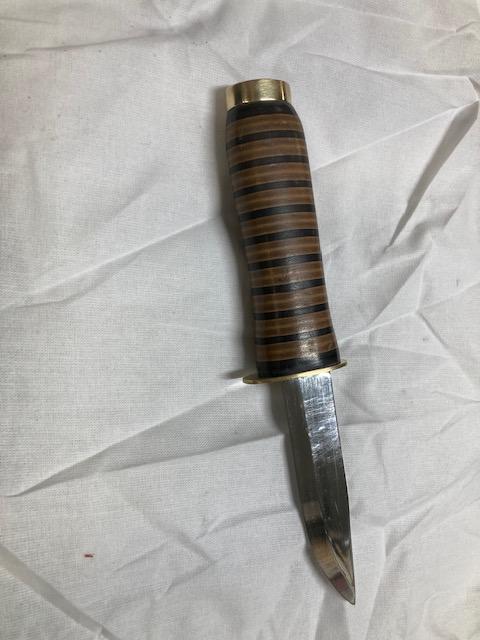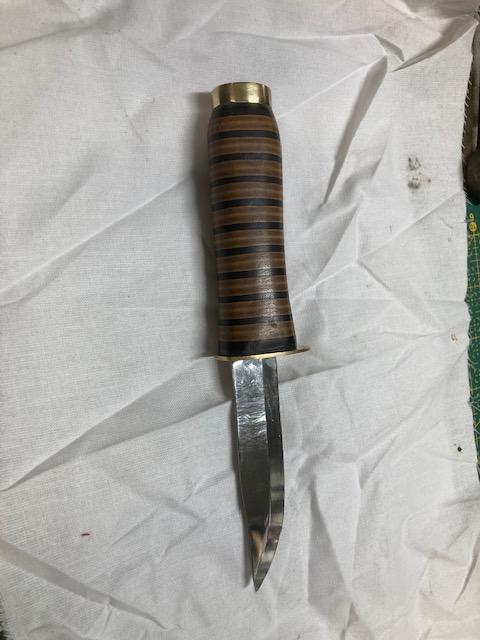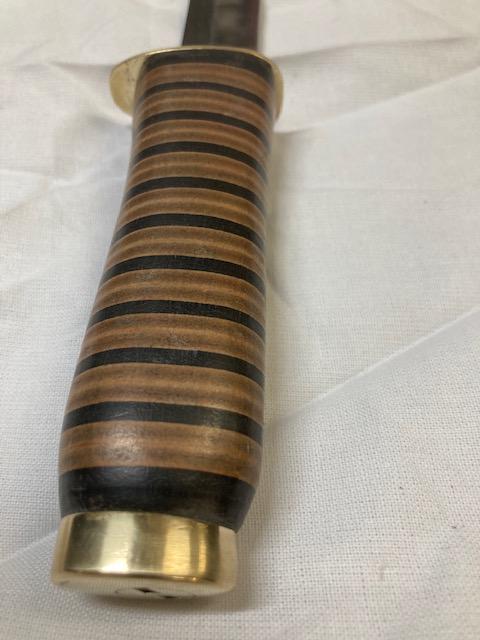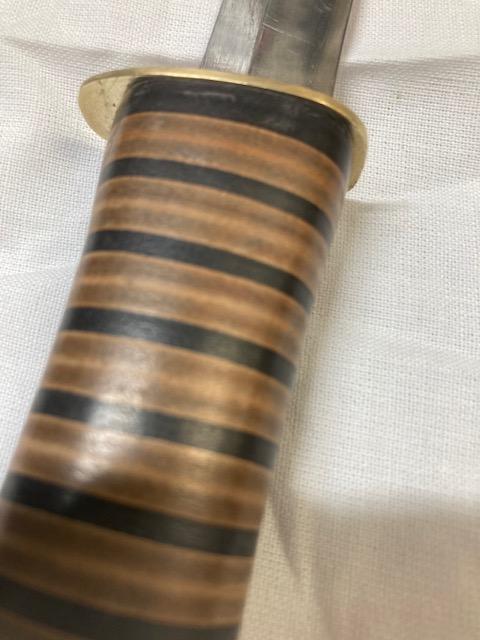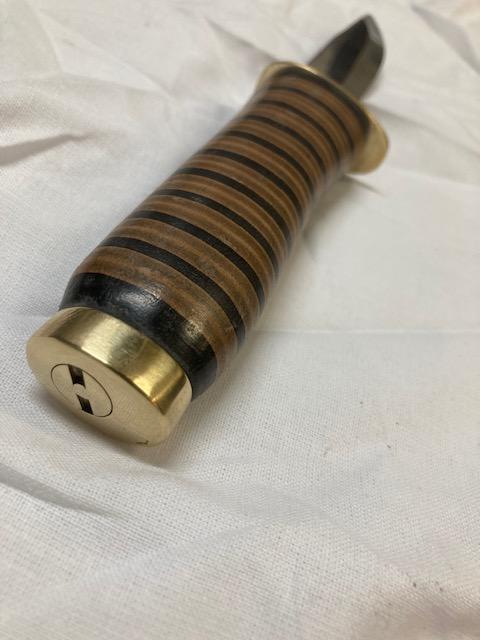-
Posts
759 -
Joined
-
Last visited
Content Type
Profiles
Forums
Events
Blogs
Gallery
Everything posted by Mulesaw
-
@TomE That worktable looks fantastic! At some point (hopefully in the near future), I am going to convert our old greenhouse to a leather shop, I might copy that idea.
-
I go pretty strict by the hourly rate x time spent. But with an allowance if I consider the job leather work or more general work. So for me the price would most likely be 8 x 350 = DKK 2800,- + 25 % VAT = total DKK 3500 (~ 500 US$) I reckon I wouldn't sell any but I have decided that I won't work for free, and a lot of people will easily spend a ridiculous amount of money on other stuff, so something that is hand made an good looking should be cheap. When / if people complain about prices I normally compare my prices to a pizza or a cup of coffee at a café. A coffee is easily 6-7 $ and a pizza 12-15$ for a regular pizza. People won't think twice before forking out money for a couple of lattes at a café, and if a job takes 8 hours for me to do - it represents an entire working day, so it should be paid like that.
-
knife with leather handle tutorial
Mulesaw replied to Mulesaw's topic in Gun Holsters, Rifle Slings and Knife Sheathes
Thanks Chuck. That makes sense. I hadn't thought about it before, and I actually tried to round the end of the tang with a file, but it was also hardened. I tried 3 times to anneal it by heating it to redhot and then slowly cooling it down (I even packed it in mineral wool insulation) But it was still too hard to file let alone threading. So that's why I soldered in a threaded rod. I am a bit uncertain if it would have been possible to been the end of it since it was so hard, and the handle would also have been a bit longer than Anna wanted. But I actually think that the original Mora knives with the red wooden handle were made the way you describe too. They have a small copper disc, like the burr of a copper rivet an then the tang is peened. Brgds Jonas -
knife with leather handle tutorial
Mulesaw replied to Mulesaw's topic in Gun Holsters, Rifle Slings and Knife Sheathes
Thanks, Yes you really never know when someone thinks it is a good idea to remove a project from the vise, so the note normally helps in this respect :-) -
Interesting discussion. I think that both stamping and carving could be considered art. But the entry level and learning curve aren't the same for the two, and also the carving could be said to go higher than the stamping. But as someone earlier said, carving needs stamping too, in order to release the full potential of the picture. I am not very good at any of them, but when I help some kids making a belt, I show them a bit of stamping, and that immediately appeals to them because the results are instantaneous and pretty good regardless of your previous skillset. Some have made star constellations using the tip of a Philips screw driver, that looks just like a small star on leather. And if the creator is happy and the recipient of the work is happy, then all is OK by me. On a side note, it is a pleasure that it is possible to have a civilized discussion even on a subject such as this with strong emotions.
-
Great looking box, I thought it was a mailbox at first too. I really like the hobby barn It looks like there is some serious sewing being done there!
-
As suggested by @Tugadude, here's a bit more information about the knife leather handle project. I didn't want to put more pictures in the last post since it was technically a "show off" post, so this is more of a technical description including the few jigs I made in order to get it to work. 1) A lot of small patches, each 1" x 1.5" were cut out from some veg tan leather and some black leather that I had. 2) the patches were soaked in water for about an hour or so, then left in a plastic bag in the refrigerator overnight (casing) 3) A model of the tang of the knife was made. The tang on this knife was wedge shaped, so I made a similar one in steel. 4) A compression plate was made. This is a small square piece of steel with an elongated hole in it. It will slide over the model of the tang. 5) a small piece of pipe was cut to a length of approx- 1.5". 6) two anti-surface-marring discs were made. I used some old gasket material, but the important thing is to have something to protect the leather from the jaws of the vise. One of those discs have an elongated hole. 7) Holes were cut in the leather patches, to make elongated holes. length of hole depends on where on the tang the patch will end up. 8) the patches are stacked on the model tang. We tried to alternate the black and veg tan patches. The veg tan patches were put flesh side to one another, and then two sets of those were stacked (4 veg tan total) 9) The entire tang is now covered in leather patches. 10) The anti-surface-marring disc is put on the model tang and it is backed up of the compression plate. 11) The anti-surface-marring disc is put in the open vise, the stack is then inserted, the pipe is placed over the end of the tang and the vise is tightened. 12) We compressed to approximately 75% of the original length. And we left the stack in the vise overnight. 13) The stack was removed from the vise. Due to the wedge shape it was easy to gently hammer out the model tang. Now there is a basic leather handle. 14) leave the handle to dry at least a day, there is a lot of moisture in it still. Once dry start basic shaping with a knife or a chisel or whatever tool you like. 15) Our knife blades are not intended for this type of handle, so I had to cut of the end and make a small slit with an angle grinder. In this slit I silver soldered a 3mm (1/8") threaded rod. 16) the pommel is made out of two pieces of brass, each approximately 5/32" thick. I drilled a 3 mm (1/8") hole in one of them and a 10 mm (3/8") in the other. 17) those two pieces are silver soldered together. 18) the retaining nut is turned on the lathe, or you can do it with a file and a drilling machine as well. It is a piece of brass of slightly smaller diameter than the large hole in the pommel. A hole is drilled and the correct thread is tapped (the same thread as the small threaded rod that is silver soldered to the end of the tang). A slit is sawn using a hacksaw. 19) Shaping of the pommel is done using a file. When the leather is dry, you can mount it all on on the knife blade and finish the shaping. 20) We glued the pommel and the last piece of leather with a bit of contact glue to prevent it from turning in case the leather dries out even more in another climate. Finally the pommel and the retaining nut are filed/sanded on the bottom, so that the retaining nut is flush with the threaded rod and the pommel itself.
-
knife with leather handle
Mulesaw replied to Mulesaw's topic in Gun Holsters, Rifle Slings and Knife Sheathes
Thanks I always tell my kids that there are two things that I can't say no to: A newfoundland dog and a young person asking me to teach them how to do something. So That's why I very often end up helping our young volunteers making a marlinspike or making a handle for a knife etc. Like you say, a lot of the knowledge will be lost if no one wants to learn it - and likewise if we don't teach it to those who would like to learn. -
knife with leather handle
Mulesaw replied to Mulesaw's topic in Gun Holsters, Rifle Slings and Knife Sheathes
Thanks Bert03241, I already showed her all the nice comments in here, and she was really happy :-) Hi Chuck, She started on designing a sheath yesterday, and I gave her a few ideas. The guard is fairly large, so she can't make a sheath the covers part of the handle. I pointed her in the direction of a sheath for a Buck 119. And she got as far as to make a template for it. So hopefully later today we'll see a sheath emerging :-) Thanks PastorBob I am amazed at how dense and hard it feels when it is compressed like this. Almost like wood, but still a different feel though. Thanks Tugadude I got her to send me the pictures she had from start, so I'll make a post about the construction, hopefully today. I might have to take a few more pictures of the setup for compressing the leather, but it should make a good post, The retaining nut is actually just a turned brass cylinder approx 3/8" in outer diameter and 1/4" high. There is a M3 thread inside (~ 1/8") and the slit in the top was made using a hacksaw. The pommel was made out of 2 pieces of brass that were first drilled, one with a 3/8" drill, one with a 1/8" drill. Next they were silver soldered together, and it was shaped using a file. The retaining nut and the thread on the tang projected a bit over the pommel, so the final shaping with a file and some sandpaper caused it all to be flush. I agree that there are things you don't expect to read/hear, and that particular phrase is a prime example -
knife with leather handle
Mulesaw replied to Mulesaw's topic in Gun Holsters, Rifle Slings and Knife Sheathes
Mora knives are great! I like the old model with a simple red wooden handle. It is so simple and yet incredibly comfortable, and the old models out of carbon steel could get wicked sharp. I think I am just as proud as her :-) She really wants to learn all the traditional techniques from splicing and using the sail makers sewing machine. I helped her repairing a hammock today using the old Adler sailmakers sewing machine we have on board. It is nice when people are interested in learning all those things. We are still underway though we have sailed faster than we had anticipated, so we'll arrive at Ponce Roads on the 10th and go alongside on the 12th. The going alongside is the same days as it was planned, but we will get an extra day at anchor before going in which is nice because it will give us a day more to shine all the brass before entering port. Brgds Jonas -
knife with leather handle
Mulesaw replied to Mulesaw's topic in Gun Holsters, Rifle Slings and Knife Sheathes
@Hags I think it is a Mora copy. There isn't a name on the blade, and though we bought them in Norway doesn't mean that the wholesale dealer didn't get them from China. Norway have some really nice blades too from Brusletto. they look very similar to Mora. Brgds Jonas -
knife with leather handle
Mulesaw replied to Mulesaw's topic in Gun Holsters, Rifle Slings and Knife Sheathes
Thanks, it was a bit more time consuming compared to making a wooden handle since the leather needed to be cased before pressing it, and then it needed to dry again, but all in all I think it was worth it, and Anna couldn't be happier with the knife and that's the most important thing. Brgds Jonas -
knife with leather handle
Mulesaw replied to Mulesaw's topic in Gun Holsters, Rifle Slings and Knife Sheathes
Thanks :-) By the way, the handle isn't as large as it seems on the pictures. It is a combination of my inadequate camera skills and a relatively small blade -
Our quartermaster onboard asked me if I would help her make a knife. I told her that I'd be happy to help her, and I suggested that instead of the wooden handles that people have made so far, we could try to make a leather handle. The blade is a store bought kind of discount blade. No name but a decent size for an everyday knife. I had brought some veg tan and some black leather with me (don't know much about it save for that it can be polished on its edges), and I instructed her to first cut out a bunch of small rectangles. We soaked those in water for about an hour or so then put them in a plastic bag and put them in the refrigerator over the night. The next day we cut some holes in the small pieces so that they would fit on the tang of the knife. The tang is kind of wedge shaped, so the upper pieces got 4 holes and the lower pieces got 2 holes. All the pieces were put in order on a jig to prevent them from sliding around while being pressed. Once mounted on the jig, it was compressed using the machinist vise in the engine room. We managed to compress the handle with almost 25 % in length. After roughly 20 hours in the vise the raw handle was removed and mounted on the tang. Anna (the quartermaster) started shaping the handle using a chisel, (we have to make do with what we have got out here). When she was satisfied with the overall contours and look of the handle she switched to some sandpaper, and finally after polishing and installing the guard and the pommel - the handle was polished using water and some canvas. For sake of clarity, I didn't do all the hard work, I just supervised and helped with stuff like silversoldering the pommel and turning the retention nut on the lathe. So Anna did the bulk of the work herself. But since she is not on LWN, I thought that I'd show off the knife for her. Tomorrow she wants to make a sheath for the knife.
-
I have seen some rifle slings that were lined with green felt. And I generally think that felt ads a touch of class to most things. If it isn't too much to ask for, if you ever get a picture of the sleight bell strap and this body strap on the actual horse, I would love to see the picture :-)
-
Local (Oklahoma City) Tandy Leather Store
Mulesaw replied to Brokenolmarine's topic in Leatherwork Conversation
Like @Tugadude suggests, send an email to Tandy. Even big companies have someone who reads the emails that are sent to them, and my guess is that they get a fair amount of angry emails. So it might brighten someone's day to have an email praising a commendable effort from one of their employees. Brgds Jonas -
Beautiful work, Is the felt edge a traditional trimming? Brgds Jonas
-
Beautiful work as always Tom! And that plough gauge looks sweet, glad to read that you are on speaking terms with it :-)
-
Lots of great ideas here. So far our little company has only sent out something like 4 packages in total, so we haven't gotten that far. But if people come to pick up a repair job, I usually ad a business card with a paperclip to the bill. @PastorBob Funny that you should mention Buck knives. I bought one about 30 years ago and still remember that inlay note that they put in the box.
-
Local (Oklahoma City) Tandy Leather Store
Mulesaw replied to Brokenolmarine's topic in Leatherwork Conversation
One single great employee can also make me return to a shop. I do most of my stuff shopping at the local lumberyard. In the pro section they are like 6 guys and one lady. They are all extremely helpful, knowledgeable and appreciate a bit of small talk. The great thing is that they can normally always match online prices, and if there is ever a problem with a product, returning it is an absolute hassle-free experience. Thumbs up to you for supporting a "local" business and telling about it. I wish more people did that. Brgds Jonas -
Beautiful work! That is a hefty amount of basket weave that goes into that case! It is impressive how much the flag stands out being painted, that effect couldn't have been replicated if you had painted the rest of the case. It gives such a great statement! Now you just need to figure out an appropriate answer when the rest of the PGR members asks you if you can make a similar case for them
-
Welcome, Good and sound advice from all above. I think that if you want to develop it into a business it is important to remember and be prepared to make stuff that people want to buy and not necessarily the stuff you would like to make yourself. Not that you should stray way out of your primary zone, but sometimes the things people like to buy and pay for are a bit different from what you like yourself. My business started out by buying an old patcher and I taught myself how to replace zippers in riding boots. That evolved into an extra patcher that I use for repairing horse blankets. Once in a while a decent leather project comes into the shop as well like repairing a headstall or some other leather gear. But the riding boots got it all started. It could easily be different in the area where you live, but if there is an equestrian center near by, it couldn't hurt to ask them if they needed anything. If you look at @TomE 's profile, you can see some magnificent halters he has made. So that could be an item if you want to produce new stuff. Personally I would love to make new stuff, but people in my area are generally more into having stuff repaired, and that is also a steady source of income. Good luck :-) Brgds Jonas
-
That's a brilliant idea!
-
That looks fantastic. Being able to see the entire bearer of the flag makes an incredible difference. Sorry for the late comment, but our Internet provider on board (Telenor Maritime ) is completely useless and unable to supply any forms of communications as soon as we leave the path generally trodden (sailed). And the South Atlantic Ocean diagonally isn't exactly a maritime expressway :-) Brgds Jonas
-
Well, I was always taught to tell the truth, and the bearer on that line drawing looks like something from a 1950'ies ad for joining the service :-)






.thumb.jpg.800d69b35e065540439e85edb2fd9a59.jpg)
.thumb.jpg.acdb94bea5ef5cb66d4881db5e0b4c6c.jpg)
.thumb.jpg.4941f21d57f1cdb6dc496fab9f8cf288.jpg)
.thumb.jpg.3feb9fe1b00783f4207d15f1e8fb2441.jpg)

